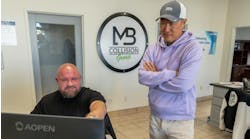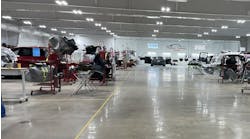Finishing touches are performed before and during the repair.
Most shops spend thousands of dollars a year to make sure their staffs are well trained and are up to date on the newest and best repair practices and materials. Paint and paint product manufacturers are constantly refining their formulas and finishes to enhance repair speed and quality. Yet, as repairers, we sometimes fail to refine our basic, simple processes and procedures to further enhance our finished product. A few basic process changes and attention to detail can raise an already high-quality product to another level. Why not exceed our customer's expectations, rather than merely meet them?
This becomes easier with just a few finishing touches. However, as you will see, not all finishing touches are done in the detail shop. They start up front. Paying attention to the details of your process is just as important as the details of the repair work itself.
First steps
Here's a simple question. When does the process involved in the repair of a prospective customer's vehicle begin? When your tech begins to work on it? Guess again. It begins the minute a customer rolls into your shop with a damaged vehicle and asks for an estimate. It begins with the damage appraisal.
No one would even consider building a house with out a blueprint. Yet even today, many shops begin repairs on a vehicle without an accurate assessment of the damage. A quick look, and a few notes, and voila. Ten minutes later the customer is down the road, with what they think is the outline of the damage on their vehicle. This is all too common in this industry. I know that this may be a slight exaggeration, but I bet it's not that far off.
You cannot produce a quality repair in a timely manner without an accurate appraisal. This process takes more than a few minutes.Getting the details right
Detail tip one: Make sure your customers are aware of the time it may take to write an accurate appraisal when they schedule their appointment. Let them know that you may need to disassemble some parts in the area of damage to see all the damage. Tell them you need the vehicle to be clean, and if it is not, pre-wash the car before writing the appraisal.
Doing so will help your estimator see all of the damage, even unrelated damage. Both can be noted on the appraisal.
Detail tip two: Let's assume the vehicle is now at the shop for repairs. Again, pre-wash the vehicle before brining it in to the shop to begin the repair process. This will serve several purposes. For one, it will help keep your shop cleaner, especially in the winter when snow and ice from the vehicle can drip on the floor as the vehicle thaws. Second, the damage areas will be easier for your techs to see and work on. Third, your paintwork will require less preparation because of the reduction in contamination on the vehicle itself. This is especially critical if you are spraying a waterborne product. In reality, it's just a better, cleaner environment for all of your staff to work in. A better, more organized, cleaner environment is more conducive to a quality repair.Detail tip three: Check the vehicle in before beginning repairs. This process involves the use of a check-off sheet at drop off, which allows you to mark the mileage, fuel level and note the unrelated damage. Try to perform the check in with the customer at the shop. Have the customer sign the check in sheet if possible. Doing so will resolve many questions and issues that could arise later. Note any valuables left in the vehicle or ask the customer to remove them.
Detail tip four: Remember that you cannot quality check a vehicle in the wash bay, after the repairs are completed. Quality must be checked at each stage of the repair process, as the vehicle progresses through the shop, at each one of the repair steps. If you do not already use one, you should create an in-process repair checklist to monitor the repair quality at each step in the process. I generally recommend a list that requires the signature of the tech performing the job and the production or shop manager to verify that the function required at each specific stage has been satisfactorily completed. If there isn't a signature of both entities on this document, the next department cannot begin its portion of the repair.Detail tip five: If you must buff the finished paint work, do so before re-assembling the vehicle. This seems simple enough but is rarely done in most shops. The reasons follow this methodology is simple.
Buffing compound is messy. When door handles and moldings are on a vehicle during the buffing process, they provide perfect areas for compound to build up and stick on. It is nearly impossible to get the dried compound out of these cracks when cleaning up the car for delivery, especially since compound residue "disappears" when the car is wet.
Additionally, if the finish is damaged or burned or your color match is less than perfect, it will be much easier to repair and repaint the damage before the vehicle is re-assembled. Once the vehicle is buffed, wash it again before re-assembly.
Detail tip six: During the entire repair process, keep the vehicle interior covered. Never put parts inside a customer's car.
I have been guilty of doing this. Many of us probably have. I never really fully understood a customer's frustration at this practice until I became one. I walked into a dealer's shop one day while my wife's vehicle was getting some service work done because I had forgotten to retrieve the garage door opener.
As I approached the vehicle with the service writer, I noticed something inside the car. As I got closer, I saw that it was part of the air cleaner box, sitting on her pristine, white leather seats. Needless to say, I was livid and finally understood fully why this should never be done.
Thankfully, there was no damage. But I have been in shops where the interior was damaged by this practice and the shop was "persuaded" to buy new interior for the car. We already have experienced a dramatic drop in gross profit margins. Consider what hundreds in additional costs will do to that margin along with the potential loss of business. Keep the interior covered and clean.
Detail tip seven: Review the completed repair line by line and verify every operation listed on the repair bill was completed. This might seem elementary, however, it is a step often left up to the technician when a member of the shop management team should be performing it. This is one mistake you won't want to make twice after a post repair audit is done on the vehicle by an insurance company at a customer's home and issues are discovered. Verify that all listed repairs were completed.
Detail tip eight: Communicate throughout the entire repair with everyone involved. This includes the customer and the insurance company. You can never communicate too much. In this age of "customer satisfaction index is everything," timely, concise and accurate repair information is paramount.
Detail tip nine: Once the repairs are completed, clean the vehicle well, close to the point of a professional detail. Shine the tires with a non-silicone tire shine, and shampoo the carpets if needed. Pay particularly close attention to the area your shop repaired. Make sure the color match is good and the texture and shine of the paint are consistent with the factory finish. Check all the door and panel gaps for consistency. If the vehicle was in a front-end collision, steam clean the engine and detail the engine compartment.
As an added service I recommend lubricating all the door hinges and latches and the hood and trunk or hatch hinges. Make sure the washer fluid reservoir is full, even if you didn't work on it. Hand glaze the entire vehicle. Make it look better than any customer would expect it to look.
Detail tip 10: Have at least two people review the repair, perform quality control and critique the vehicle. Do not accept flaws, and make sure every function of the vehicle works properly. If an unrelated problem arises, note it. Call the customers and inform them before they come to pick up the vehicle.
Never call a customer to come and pick up a car until it has been inspected and it passes all the quality steps listed. I have been in shops where a customer will arrive to pick up a car while it is still being put back together. After an hour wait and a quick wash, the dripping wet car is rolled around to an already unhappy customer.
Invariably, something is discovered that is wrong with the repair, and a bad situation becomes worse. This is not good customer service and could cause you to lose thousands of dollars in a direct repair program or customer-referred business.
The best laid plans
Remember these finishing touches. Start up front with a clearly laid out process that everyone in your shop understands and is part of. Your staff wants to perform a quality job that everyone can be proud of.
It's your job to provide them with the inspiration and the tools to make sure this happens. When all those things fall into place, you can expect that your customers' expectations will be exceeded as well.




